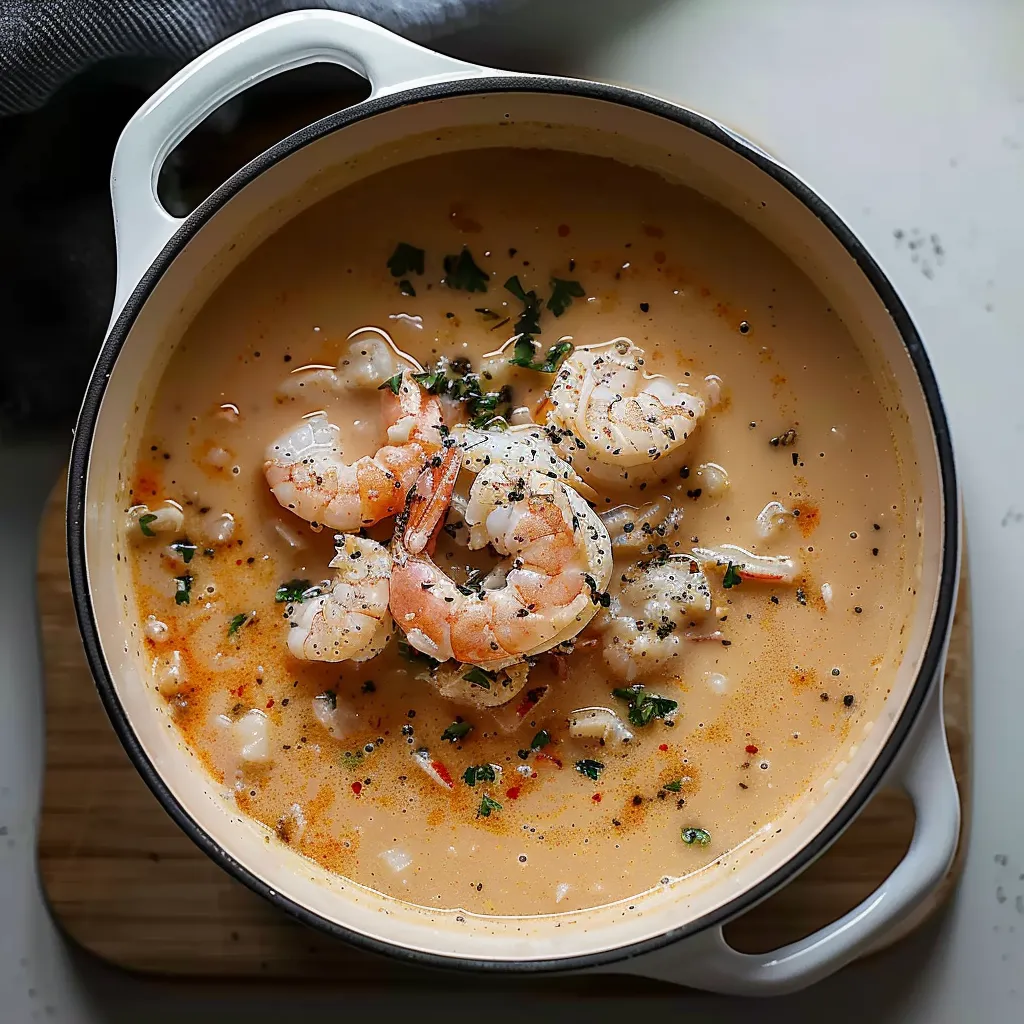 Pin to Favorites
Pin to Favorites
The first spoonful of a perfectly made Crab and Shrimp Seafood Bisque is nothing short of magical. That velvety texture gliding across your palate, carrying the sweet, delicate flavors of fresh seafood enhanced by a rich, buttery broth – it's an experience that lingers in your memory long after the meal is over. Though often considered restaurant fare, I've spent years perfecting this recipe in my home kitchen, discovering that with the right techniques and quality ingredients, this luxurious soup is surprisingly achievable for home cooks. What began as a special occasion dish has become a beloved favorite that my family requests regardless of season.
Last winter, I served this bisque as a starter for a small dinner party. My friend Mark, who typically avoids seafood, hesitantly tried a spoonful at his wife's insistence. The look of surprise and delight that spread across his face was priceless – he ended up asking for seconds and then discreetly requested the recipe before leaving. The secret? Taking time to develop flavor at each stage and using the freshest seafood you can find.
Essential Ingredients and Selection Tips
- Crabmeat: Fresh lump crabmeat is ideal for its sweet, delicate flavor and tender texture. Refrigerated crabmeat is superior to canned varieties.
- Shrimp: Use medium-sized raw shrimp (16-20 count per pound) with shells on if possible. Shells can be used to make a quick seafood stock.
- Heavy Cream: Non-negotiable for achieving the signature velvety texture. Substitutes significantly impact the final result.
- Seafood Stock: Homemade stock using shrimp shells and fish trimmings adds incredible depth compared to store-bought versions.
 Pin to Favorites
Pin to Favorites
I've discovered that the quality of seafood makes all the difference in this recipe. When possible, I visit my local fishmonger on the day I'm making the bisque. The conversation usually includes what's freshest that day, and they often provide helpful preparation tips specific to their products.
Detailed Cooking Instructions
- Create a Flavorful Base:
- Melt 1/4 cup unsalted butter in a Dutch oven over medium heat. Add finely diced onion, minced garlic, and diced celery with a pinch of salt. Cook for 5-7 minutes until softened but not browned.
- Master the Roux Technique:
- Sprinkle 1/4 cup all-purpose flour over the vegetables, stirring constantly. Cook for 3 minutes until golden and nutty in aroma.
- Incorporate Liquid Gradually:
- Slowly whisk in 4 cups seafood stock, adding in three parts to ensure a smooth consistency. Simmer for 10-15 minutes.
- Add Richness and Depth:
- Reduce heat to low and stir in 1 cup heavy cream. Optionally, add 2-3 tablespoons of sherry or brandy for depth of flavor.
- Prepare and Add Seafood Properly:
- Add peeled, deveined, bite-sized shrimp pieces and cook until pink, about 2-3 minutes. Gently fold in lump crabmeat and heat through for 1-2 minutes.
- Season Thoughtfully:
- Adjust seasoning with salt, white pepper, a pinch of cayenne, and a squeeze of fresh lemon juice.
- Finish and Garnish With Care:
- Ladle into warm bowls, garnish with fresh chives or parsley, and serve with crusty bread.
Early in my cooking journey, I made the classic mistake of boiling my bisque after adding cream, resulting in an unappetizing curdled mess. That experience taught me the importance of gentle heat and patience when working with cream-based soups.
The Art of Stock-Making
The secret to exceptional seafood bisque lies in homemade stock. I save shrimp shells in the freezer and use them to make a quick stock by sautéing them, then simmering with water, white wine, bay leaf, and peppercorns for 30 minutes. This approach connects me to traditional cooking methods and dramatically improves the final bisque.
Texture Perfection Techniques
Finding the ideal consistency for seafood bisque took several attempts. I discovered that partially blending the bisque creates a smooth yet textured soup. An immersion blender allows for partial pureeing before adding seafood, ensuring a velvety base while keeping whole pieces of seafood intact.
Seafood Selection Strategies
Freshness indicators are crucial when shopping for seafood. Shrimp should be firm with no black spots and a clean, oceanic smell. Crabmeat should be sweet and briny, never fishy or ammonia-like. Building a relationship with a seafood monger allows for flexibility in sourcing the best ingredients.
Make-Ahead Secrets
Bisque is best fresh, but the base can be made a day ahead. Refrigerate after cooking up to the point of adding seafood. When ready to serve, gently reheat, then add the seafood as directed. The flavors meld overnight, making for an even richer soup.
I learned the importance of these techniques through years of practice, including one memorable disaster when I tried to shortcut the roux process for a dinner party. The resulting bisque had an unmistakable flour taste that no seasoning could mask.
The beauty of mastering seafood bisque lies in transforming simple ingredients into something truly special. What begins as vegetables, stock, and seafood becomes an elegant dish worthy of celebration. I'm reminded of this magic each time I ladle the bisque into bowls and see my family's faces light up. In our busy household, this bisque represents more than just dinner – it's a moment to slow down and savor something created with care.
 Pin to Favorites
Pin to Favorites
Frequently Asked Questions
- → Can I make this seafood bisque ahead of time?
- Yes, you can make this bisque a day ahead. Prepare it through adding the cream, but add the seafood only when reheating to prevent overcooking. Reheat gently over low heat until just simmering before adding the crab and shrimp.
- → What can I substitute for the heavy cream?
- For a lighter version, you can substitute half-and-half or evaporated milk, though the bisque won't be as rich. For a dairy-free option, full-fat coconut milk works well and adds a subtle complementary flavor to the seafood.
- → Can I use different types of seafood in this bisque?
- Absolutely! This recipe works well with lobster, scallops, or even a seafood medley. Just adjust cooking times accordingly as more delicate seafood like scallops will cook faster than shrimp.
- → How do I prevent curdling when adding the cream?
- To prevent curdling, make sure the soup isn't boiling when you add the cream. Reduce heat to low, and consider tempering the cream by adding a small amount of the hot broth to it first, then slowly incorporating the mixture back into the pot.
- → What's the best way to serve this bisque?
- Serve this bisque in warm bowls garnished with fresh parsley. It pairs beautifully with crusty bread or oyster crackers. For an elegant presentation, reserve a few pieces of crab and shrimp to place on top just before serving.
